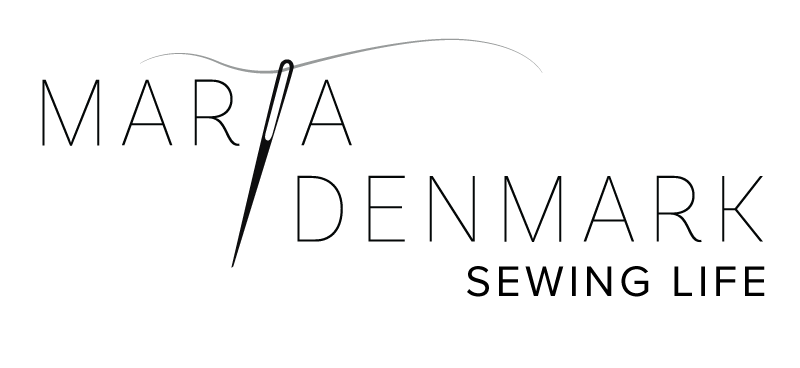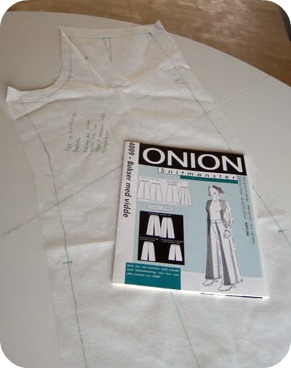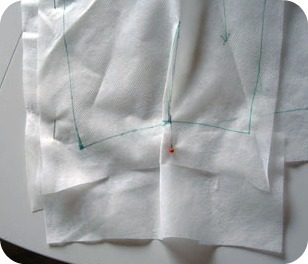I wrote and posted this tutorial on fitting trousers in 2007 originally. The pictures aren’t very good, but they’ll illustrate what I write about. I’ve updated the post a bit and changed links etc. Enjoy:
Do you know the feeling that suddenly some item of clothing has completely vanished from your closet (like suddenly you have no t-shirts or no socks, or indeed no trousers – at all!)? In 2007 I suddenly had no trousers/pants – they were all worn out or too small or had holes. So I sewed something like 5 pairs in a row (from 3 different patterns).
Anyone is able to sew their own trousers, but I’ve heard even talented and experienced sewers saying, that they just can’t make trousers, mostly because they feel that they can’t do the trouser fitting , so that’s why I am now inviting anyone interested to follow the creation of some – and maybe even get inspired to try for themselves!
The most inportant thing, in fitting trousers is – in my opinion – to adjust the pattern before cutting into fabric. It sounds like a lot of work, but you only do it once with every new pattern (unless you gain or loose 5 kg, then you have to try the pattern on again) and you can use the same pattern again and again! The entire process of adjusting the pattern usually takes me 2 or 3 hours, including tracing the pattern at the beginning, and you don’t have to do it all on the same day!
I learned the techniques from the book Pants for Real People and from following discussions on Patternreview.com:
Today there are many more books on fitting trousers available, but I haven’t tried any of them, so I cannot give any recommendations besides this one.
Fitting trousers by tissue fitting
Well, let’s get to i!
In this tutorial I’m making myself a pair of dress trousers. I used ONION 4009 (sadly now Out Of Print – I’m hoping for them to be reprinted) because 1: they have really wide legs, which I really like and 2: they have a wide waistband, which is great for keeping any stomach-fluff hidden! And then they are simple to sew.
First thing I do when I’m fitting trousers is tracing the pattern onto tracing paper. You can use any kind of thin tracing paper, but I prefer Swedish tracing paper or similar soft tissue/almost-like-interfacing-paper.
In the first picture I have traced the pattern and left plenty of room for extra wide seam allowances – or really for the alterations – leave at least 5 cm (or 2 inches) . Use the size that correspond with your hip-width.
Then I pin the front and back piece together, to make the pattern ready for trying on (yep, really!).
I place the pins 5 cm apart right in the seam line:
A piece of elastic around the waist keeps the pattern pieces up for the trouser fitting (and here is where I am a little shy) and then I’m ready to evaluate the pattern fit. I use a big mirror and a hand held mirror to see myself from behind, and I just started using the timer function on my camera – and that is really great for a more objective evaluation!
All the alterations shown here are really just for me, each body needs different alterations on different patterns when fitting trousers , but checking the side-seams and the center-front and center-back is the same for everyone.
I begin by having a look at the front piece. The crotch seam has to reach the center front (right uder my belly button). It didn’t on me, so I have to let out the side seam. If you use pattern with front darts, it might be enough to just let the darts out (you really only need those if you are under 25 and still have a stomach that goes inward :-)
Once the side seams are corrected (take off the pattern, undo the pins and lay the pattern flat before you repin), I’m trying it on again to see if the back piece crotch seam reaches my center back. This one did, but it’s easy to see that there is not enough material to cover everything (my bum), so I have to add material to the back piece to make it reach the elastic.
I place the pattern flat, and tape additional tracing paper to the piece.
Then I try the pattern on again and check to see if everything is ok so far, before I move on. (In this pic, I didn’t pull the pattern paper up right. You are supposed to do that!)
Now I move on, concentrating on evaluating weird folds and lines. As you have been doing this with different patterns a few times, you begin to realise that you always need to do the same kind of alterations (if you use European patterns, anyway, because they are almost all drafted using the same recipe).
In my case it’s something about the width of the back piece on trousers. There always seem to be too much material across (I’ve already done the vertical tuck following the grainline on these before tracing), and also usually something with folds just under the buttocks.
Also on this pattern – in this picture I’ve folded and pinned the redundant material, to see how much needs to go…
How to fix this is a little complicated, I need to make what is called a “fish-eye-dart”, without actually sewing it (so it has to be in the pattern piece). Debbie Cook explained it very well, so there is no need for me to repeat it – look HERE for a tutorial on this alteration!
Other problems are well described in the book, and also people are always ready to help solving “folds and lines” at Patternreview!
All alterations must be transferred to the pattern pieces:
Since everything is now ok (It doesn’t have to be perfect!! ), the side seams hang nicely and the more obviously fold and lines are gone, I’m going to prepare the pattern for cutting.
I always add seam allowances to patterns I know I’m going to use more than once. In this case I’m adding 2 cm to side seams and waist, 1,5 cm to crotch seam and inseam and 4 cm to the hem. I note this on the pattern, but also on a post-it note I can stick to the sewing machine while sewing the pattern.
And then I have to remember to adjust the waistband pattern pieces so they fit the front and back pieces.
To sum it up: First look at and fix the front, second the back. Then look at weird fold lines and finally transfer the alterations to the pattern!
When all this is done, I’m ready to cut the fabric…..


















Wow, this is a great tutorial, thank you for posting! It’s really helpful having photos showing you fitting the paper to your body, I’ve read about it but never known quite how to do it myself. I’ve never sewn trousers, out of fear, but I am very tempted to give it a go now!
You are welcome. Now go on – give it a try :-)